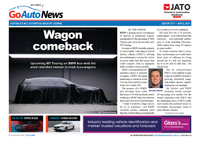Make / Model Search
News - HoldenGMH launches green supply plan as auto review nearsGreener line: Commodore production at Holden's Elizabeth plant. GM Holden jockeys for position in the lead-up to the Bracks auto industry review3 Apr 2008 THE Federal Government has moved to allay fears by some industry quarters that the lion’s share of its $500 million Green Car Innovation Fund, which aims to assist the manufacture of low-emission and fuel-efficient vehicles in Australia for five years from 2011, could go to the likes of Toyota for the production of its proposed Camry Hybrid. Speaking at yesterday’s launch of the Greening the Supply Chain initiative between GM Holden and the World Environment Centre, which aims to promote sustainable development among Australian automotive industry suppliers and is part of the Australian government’s $7.2 million Supplier Capability Development Program, the minister for innovation, industry, science and research, senator Kim Carr, said the government was “agnostic” when it comes to technologies that will promote an environmentally-sustainable vehicle manufacturing industry. Providing the clearest indication yet of the types of technologies for which the government will consider financial assistance, Mr Carr said a range of vehicle and transport systems will be considered as part of a review into the Australian automotive industry by former Victorian Labor premier Steve Bracks, who issued background and discussion papers on March 31 and has called for public submissions ahead of his final report to government on July 31. “The government will contribute one dollar from the fund for every three dollars put up by industry. We are agnostic about the technology – hybrid, hydrogen combustion, hydrogen fuel cell, flexible fuel (petrol-ethanol), clean diesel, LPG – they are all on the table. So are technologies to make vehicles lighter and more aerodynamic,” he said yesterday.  Left: Senator Kim Carr, minister for innovation, industry, science and research. Left: Senator Kim Carr, minister for innovation, industry, science and research.Toyota Australia has long been vocal in its desire to produce a petrol-electric hybrid version of its Camry sedan locally, but fired a shot across the government’s bow in October last year when senior Toyota Motor Corporation executives in Tokyo warned the future of its Australian plant could be in danger if the manufacturing climate shifted due to government policies including the scheduled reduction of the vehicle import tariff from 10 to five per cent in 2010. The new Australian Labor government’s Green Car Challenge to the industry has pledged to purchase “hybrid or other value-for-money, environmentally-friendly vehicles” for the Commonwealth fleet if they are produced in Australia. But Toyota Australia Technical Centre vice-president Max Gillard told GoAuto on March 24 that both state and federal governments needed to offer more incentives for buying hybrid vehicles and that neither body had made clear its position on hybrid cars. Privately, senior Toyota Australia officials also point out the fact that rivals Ford Australia and GM Holden received the majority of the last round of ACIS funding. In tabling his interim report on Monday, Mr Bracks said the question of tariffs was overshadowed by exchange rate issues, production volumes, worldwide competition and export markets. Both tariffs and the future of the $7 billion Automotive Competitiveness Investment Scheme (ACIS) are nonetheless expected to be major focuses of Mr Bracks, who this week told GoAuto it was outside the panel’s brief to look at fuel tax regimes or other strategies to encourage more widespread use of fuels like diesel, ethanol, LPG and natural gas. While GM has recently embarked on a global push toward engine technology fuelled by ethanol produced from non-food sources as a means to reduce its fleet’s dependence on crude oil, Holden’s former chief of advanced engineering Laurie Sparke told a Society of Automotive Engineers conference last month that the solution to reducing Australia’s reliance on petrol and diesel was LPG and natural gas. Signalling the likelihood of government assistance for GM Holden under the GCIF next decade, Mr Carr’s address yesterday at Holden’s Port Melbourne headquarters mentioned cylinder deactivation as a key technology worthy of tax-payer funding. “Technologies to make vehicles operate more efficiently – such as cylinder deactivation, dual-clutch transmissions, common axles and drive-chain improvements. Even technologies to help vehicles get through traffic more smoothly, such as intelligent transport systems and telematics,” he said. It’s unclear whether Holden would have to delay the local introduction of its “Displacement on Demand” cylinder shut-down technology, which already features on the Gen IV 6.0-litre V8 that powers its VE Commodore SS sedan-based Pontiac G8 currently exported to the US, to be eligible for the “green” funding. “Any idea with a serious chance of reducing the carbon and other environmental impacts of Australia’s vehicle fleet will get a hearing. I’ve already made it clear that we will not be putting the entire fund into one vehicle, company or technology. “We welcome the contest of ideas and we are ready to support a variety of solutions. We are especially keen to develop solutions that will find markets overseas. This is an international industry and Australia needs to become an integral link in the global supply chain. “With this in mind, I am planning to travel to the United States in June to discuss the government’s proposals with auto industry leaders,” said Mr Carr, who travelled to Japan in the wake of Toyota’s comments during the 2007 Tokyo motor, to canvass a number of companies, including Toyota, about the green funding plan. Mr Carr told the National Press Club of Australia on March 19 that it was “not feasible” that one technology would receive the GCIF’s entire $500 budget. “We are clearly aimed at ensuring that we use public money well, we get value for money and that we have a co-investment approach to industry development. It is clearly not feasible that one company would take all of the fund. That would be frankly a nonsensical proposition and that’s not our intention. Our intention is to work with companies for them to come to us with specific proposals and to ensure that there is on a co-investment basis they are able to put practical measures before the government and for us to actually discuss that within the industry. “Clearly we are in the business of moving as quickly as we can to establish the framework in which the industry itself is able to transform. “I want this industry to be put on a sustainable basis. Now if one of those questions arises in regard to a particular form of technology we will have a good look at it, but we’re not going to be prescriptive. After all to develop a new model costs something like a billion dollars, a billion dollars. It has a lifespan of about seven years. So these are not simple things that you simply turn on and off. “We’re not saying it has to be a hybrid, we’re not saying it has to be diesel, fuel cells or any other particular technological form, after all it’s the companies that have got to make decisions. “Mitsubishi made some decisions about a particular model, and as a consequence that model didn’t sell. A lot of people paid the price for that, but in the end it’s not Government’s job to guarantee that company executives will make the right decisions. Our job is to try to work with them and provide the policy framework to provide the highest level of certainty that the right decisions are in fact made,” said Mr Carr in Canberra two weeks ago. “We won’t be in the business of telling companies what to do. We won’t be in the business of prescribing particular technologies. We will be in the business of discussing with them the options for the future and it is companies that put money on the table. We will work with them to ensure that the full range of options are available and that’s the process in which I’m engaged right now. “There are some 12 countries around the world that enjoy the capacity to build a vehicle, that is from design through to construction. We’re one of them. Every one of those countries has a very strong relationship between its government and the local industry. “Many of those countries have much more substantial relationships than we do and I want to ensure that our relationship with the auto industry is placed one within its international context and two on a sustainable basis. And three ensure that the skills development, the research and development capacity of the industry and the ability to make products that people want to buy, is maintained in Australia,” said Mr Carr. For its part, four months out from the finalised Bracks industry review, Holden’s announcement yesterday confirmed 17 of its suppliers in Victoria and South Australia had signed up for its of the “Greening the Supply Chain” program, which the company says represents an important opportunity to improve the sustainability of manufacturing processes in its supply chain. “This program represents GM’s latest efforts in its long-term commitment to support the development of Australia’s automotive industry,” said GM Holden’s executive director of corporate affairs, Alison Terry. “We certainly expect to generate tangible benefits for our suppliers in terms of improved energy efficiency and water reduction. “It is a great opportunity and the number of suppliers who are putting up their hands to be involved in the program is very encouraging,” said Ms Terry. The WEC is an independent, global non-profit, non-advocacy organisation that advances sustainable development through the business practices of member companies and in partnership with governments, multi-lateral organisations, non-governmental organisations, universities and other stakeholders. The “Greening the Supply Chain” program was initiated by the WEC and has been launched in Mexico, Brazil, Romania and China, where GM realised significant energy efficiency, environmental and water conservation improvements on the program’s completion in August 2007. Read more:Toyota sticks to hybrid scriptCamry Hybrid put on hold LPG the answer to an inconvenient truth Toyota Australia hybrid gains momentum |
Click to shareHolden articlesResearch Holden Motor industry news |









Facebook Twitter Instagram